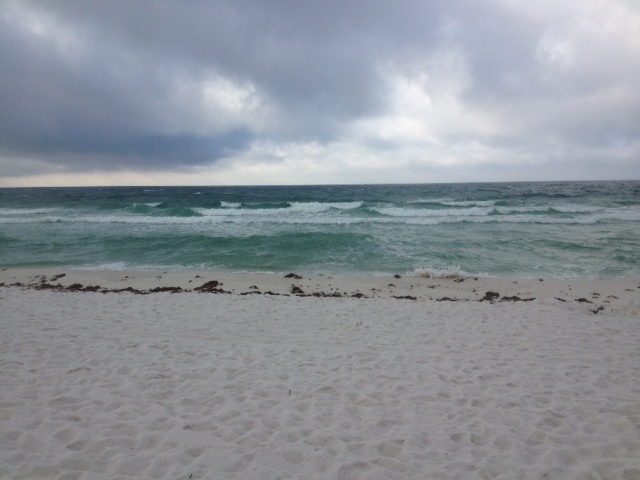
by Rick O'Connor | Apr 17, 2015
As we left the winter months and headed into spring I was expecting a lot of new blooms, new animal tracks, and more live encounters with wildlife… and then the rain began. I do not know if the entire panhandle has been getting what Pensacola has but the rain has been nonstop for over a week now. I track rain days for a water quality project and for the first three months of 2015 the number of days during a month where it rained was between 23-30%. We are about half way through April and so far it has rained 61% of the days. WELL… rain or shine we will make this hike and see what is happening on our barrier island.
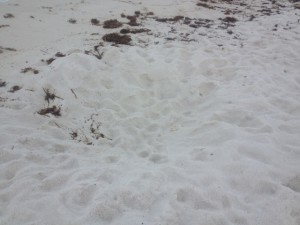
Hole left by a sand castle architect. These can be problems for wildlife and rescue vehicles. Photo: Rick O’Connor
The first thing I noticed when I began the trip along the Gulf was this large hole left by a sand castle architect. These can be problematic for some forms of wildlife, including sea turtles, but they can also be a problem for rescue and turtle watch vehicles. Please enjoy the beach and make awesome sand castles, but when you are finished please fill the hole.
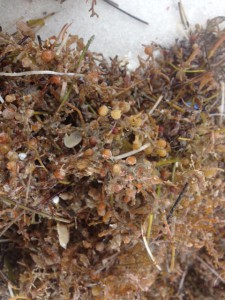
Sargassum is floating form of brown algae. Notice the “air bladders” (pneumatocyst) Photo: Rick O’Connor
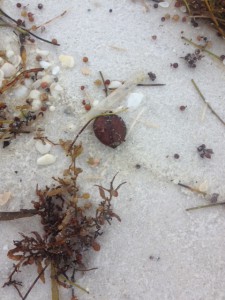
A tropical seed commonly referred to as a sea bean. Photo: Rick O’Connor
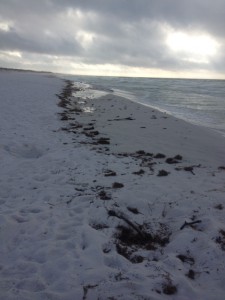
The line of seaweed and debris along the surf zone is called wrack. Photo: Rick O’Connor
The line of seaweed and debris that washes ashore during storms is called the wrack. For the most part it is natural material and provides the nutrients needed for many of the high energy shoreline plants to grow. Many of the beach animals found in the berm and primary dune depend on this wrack as well. Many locals and visitors find this material and eye sore and, at times, producing an unpleasant odor. But this material is an important part of the beach ecology. Sargassum is a drifting member of the brown algae, sometimes called “gulfweed”. It possess small air bladder structures called pneumatocysts that allow it to remain at the surface of the open Gulf where the sunlight is. These large offshore mats of Sargassum have been targets for local fishermen for decades. Many small invertebrates live in these drifting mats and these are targets for small fish, which in turn are targets for even larger sport fish. They are also the hideaway for sea turtle hatchlings. When the little guys head for the Gulf after hatching this is where they are heading. Large ocean currents, including the Gulf Stream, push Sargassum into large mats in the middle of the open ocean. The area within the Atlantic where this happens in known as the Sargasso Sea. If you get a chance this summer, grab a small hand net and mask when the Sargassum is just offshore. Collecting you may find a lot of cool interesting creatures. Sea Beans is a generic word for a variety of tropical seeds that wash ashore in the northern Gulf. Some of these may sprout, including mangroves, but most will not make it through our winters.

The Blue Button Jellyfish is a tropical cousin of the Portuguese man-of-war. Photo: Rick O’Connor

The Portuguese Man-of-War is one of the more venomous jellyfish in Florida waters. Photo: Rick O’Connor.

A variety of shorebirds utilize the wrack. Photo: Rick O’Connor
One of the more venomous jellyfish in Florida waters is now making its way onto our shores. The Portuguese man-of-war, named for the many “guns” this animal possess, is well known by locals but not so much by some of our visitors. The man-of-war is actually not one animal but a colony of sedentary polyp jellyfish that produce an inflated bag which floats at the surface carrying them across the sea. The dark blue tentacles hang down into the water column where passing fish are stung and consumed. Each of the polyps have connecting stomachs which helps move the food around to the whole colony. The sting of this jellyfish is quite painful and should be avoided. When they arrive life guards will usually fly a purple flag.
Their close cousins, the Blue Button Jelly, is very similar to the man-of-war albeit they are much smaller and the venom is not as potent. They are more tropical and not common along the northern Gulf but in recent years more have been washing ashore; they are here now.

A variety of plastics ends up in the Gulf. Each is a potential problem for marine life. Photo: Rick O’Connor
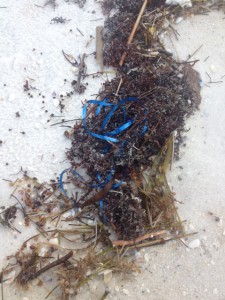
Pieces of plastic ribbon resemble jellyfish tentacles and are frequently consumed by sea turtles. Photo: Rick O’Connor
One of the bigger issues are oceans are facing are discarded plastics. These materials takes years to decompose and are found in all oceans and seas. Even some distant isolated islands have huge piles of this form of marine debris. Plastics can entangle marine organisms or they may actually swallow it, plugging their digestive system and eventually starving them. We encourage locals and visitors alike to help with this problem by taking your trash with you and discarding it in a location where it will not reach the Gulf.

This ephemeral pond formed around a small dune which becomes a temporary island. Photo: Rick O’Connor
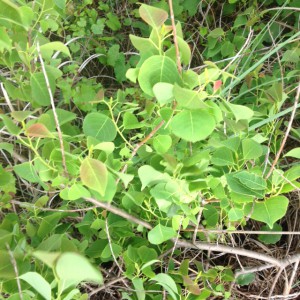
The Chinese tallow is an invasive species the entire state is dealing with. Photo: Rick O’Connor
With the heavy rains of the last week ephemeral ponds have formed on parts of the island. These small pockets of freshwater can be “manna from heaven” for many island residents, particularly the amphibians. I have been hiking this section of Pensacola beach for years, leading field trips for all sorts of groups. I have never seen this Chinese Tallow until today. Also known as the “popcorn tree” due to its unique looking fruit, this plant is listed as an invasive in the state of Florida and is very aggressive. I did not see any others and will seek permission to remove it before it spreads to other dunes and out competes the native plants.

One of the few plants blooming in April, the Spiderwort is a common weed in many lawns. Photo: Rick O’Connor
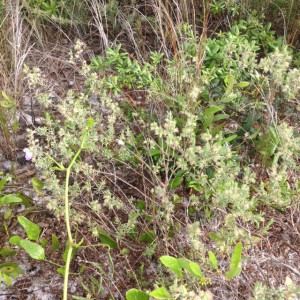
The blossoms of Conradina first appeared in February. They are all but gone this time of year. Photo: Rick O’Connor
I was actually expecting more flowers to be in bloom this month but there were few. The Conradina, which have been in bloom since February, have lost most of its blossoms. The “new kids on the block” are the Spiderwort, the Primrose, the Sandhill Milkweed, and the Devil’s Joint Cactus.
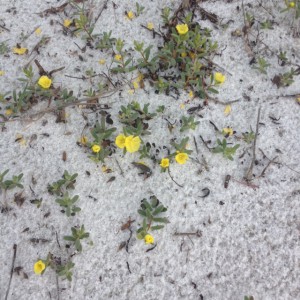
There are a variety of primrose that grow on our barrier islands. They are beginning to bloom now. Photo: Rick O’Connor

New growth on a pine tree. Photo: Rick O’Connor
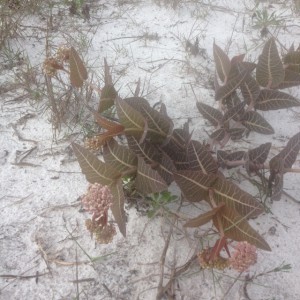
The Sandhill Milkweed. Photo: Rick O’Connor
The Sandhill Milkweed is one of the plants used by the monarch butterfly to gain fuel for their great flight across the Gulf to Mexico. The milky toxic sap of this plant is consumed by the monarch caterpillar but it does not harm it. The chemical toxins therefore become a defense for the monarch and the butterfly has earned the respect of many birds; though it may be a trial and error learning experience.
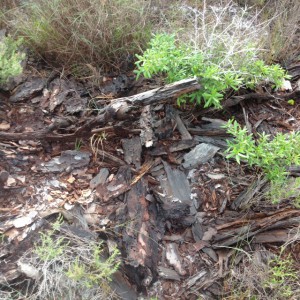
A decomposing log is a microhabitat for many organisms. Photo: Rick O’Connor
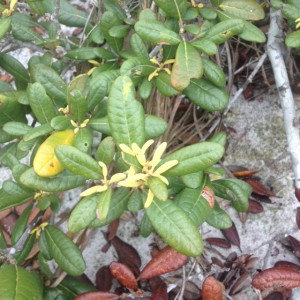
New growth on a live oak. Photo: Rick O’Connor
Most environmental centers, state and federal parks, leave fallen trees where they lie. The tree is actually a storage house of nutrients and full of cavities that can be used by a lot of organisms within the beach community.

The mysterious “drags” we have seen the last three months were not to be found in April. Photo: Rick O’Connor.
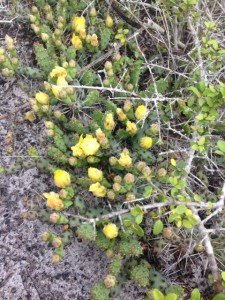
The beautiful yellow bloom of the Devil-Joint cactus. Photo: Rick O’Connor
This month the weather was warm enough for me to venture into the Salt Marsh. Salt marshes are wetlands but differ from swamps in that the dominate plants are grasses, not trees. Our local salt marsh is dominated by two species of grass, the Smooth Cordgrass, and the Black Needlerush. There are many other plants that exist here but these are the most common. This particular marsh is dominated by Black Needlerush. Salt marshes are one of the most productive systems on the planet, producing tons of organic material annually. 90% of the commercially valuable marine species spend part or all of their lives here. There are many unique species to this system as well. Today the water was crystal clear but I saw few fish. I expect as it gets warmer we will see more. It is very possible that with the heavy rains that they have moved to deeper, saltier spots in the Sound.
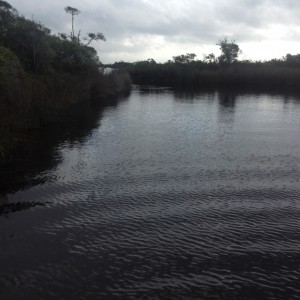
It’s warm enough to enter the salt marsh. Photo: Rick O’Connor
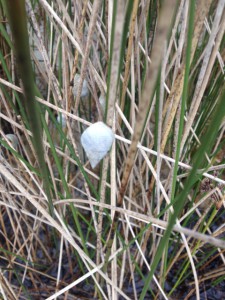
The marsh periwinkle is one of the more common mollusk found in our salt marsh. Photo: Rick O’Connor
The Marsh Periwinkle is an interesting guy. This snail will crawl up the stalks of marsh plants during high tide to avoid predators like blue crab and diamondback terrapins. Both of these predators appear to be on the decline and it will be interesting to see how this impacts the ecology of the marsh. At low tide the periwinkles descend and feed on the organic leaf litter on the muddy bottom.
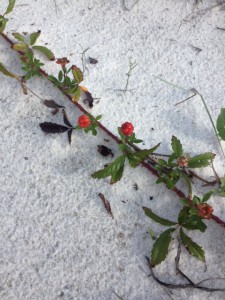
This dewberry has flowered and the dark fruit will be ready next month. Photo: Rick O’Connor

Gracilaria is a common epiphytic red algae growing in our seagrass beds. Photo: Rick O’Connor
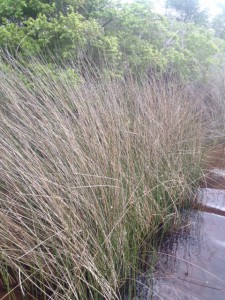
Black Needlerush is one of the two dominant plants of our salt marshes. Photo: Rick O’Connor
Though it has a white appearance, Gracilaria is a member of the red algae group. This algae grows on seagrasses as Spanish moss grows on oaks. The plant is usually kept in check by herbivorous grazers, such as green sea turtles, but in recent decades the number of predators have declined and the amount of nutrient runoff has increased. This has sparked a increase in the growth of this algae and, in some cases, to the determent of the seagrass itself.
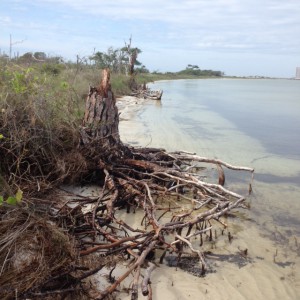
This eroded pine tree gives evidence of the ever changing shorelines of our barrier islands. Photo: Rick O’Connor

This submerged mound of peat is the remnants of a salt marsh which is now below sea level. Photo: Rick O’Connor
These photos of peat and the eroded tree are indications of a changing shoreline. Due to storms, boat wake, and time, the shoreline of Santa Rosa Island, like all barrier islands, is changing. Peat is actually the remnants of an old salt marsh that has now pass the high tide line and is within the Sound.
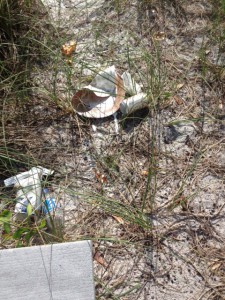
Trash left behind by those enjoying the beach. Photo: Rick O’Connor
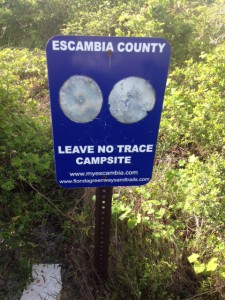
We encourage those who pack it in… to pack it out. Photo: Rick O’Connor
As the weather has warmed and spring break has fallen upon us I have noticed an increase in the amount of trash on this hike, both the Gulf of Sound sides. We encourage locals to take their trash with them and encourage visitors to do the same. Let’s try to keep our waste out of our waters.
I am expecting some animal nesting in May. We will see what we find. Until then.
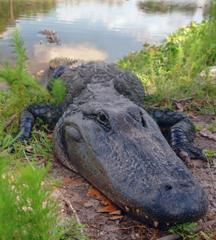
by Rick O'Connor | Apr 10, 2015
The American Alligator is an icon in the state of Florida. Viewed on the program “Swamp People” and as the mascot of the University of Florida, most visitors to our state view this animal more on television than in the wild; but they are certainly there. In need of mates and calories from the lack of eating over the winter, alligators and other reptiles become more active this time of year. Visitors and residents alike should be a little more cautious.
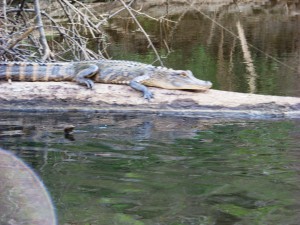
Alligator basking on the Escambia River; photo: Molly O’Connor
Like most predators, alligators seek food that will provide them energy. Generally predators will target prey that will cost them very little energy to capture and kill. Obviously small alligators will feed on small prey but adult alligators feed on smaller prey than many think. Fish, turtles, snakes, small mammals and birds make up the bulk of their diet. If the opportunity presents itself, and they do not have to expend too much energy, alligators will certainly take larger mammals and birds.
For humans the bigger problem has been the loss of pets and livestock. Small dogs are certainly easier prey than a human, and with the loss of habitat encounters with humans and their pets have increased. Since 1948 FWC has estimated about 300 alligator attacks on humans directly, less than 10% of these were fatal. As more alligators are forced into suburban areas more encounters have occurred. In the last 10 years 16,000 nuisance alligator calls have been reported to the FWC. As with other wildlife, like coyotes, many of these animals are living in ditches and other watering holes where they seek fish and turtles. However if we visit such places, particularly with our pets, these animals may certainly make an attempt to grab them. If you feel an alligator is a nuisance and could be a potential problem you can call FWC at (866) FWC-GATOR; (866) 392-4286). Folks should be aware that FWC does not relocate nuisance alligators, they will be destroyed. Currently FWC issues about 7000 permits for alligator control across the state.
A couple of safety notes if you live near waterways with alligators.
- Do not swim in these locations at night; alligators are more active hunters between dusk and dawn
- Try to discard fish remains after cleaning in another location besides the water; if these locations have a few alligators they will certainly learn this habitat and hang around the boat ramp more.
- DO NOT FEED alligators; help us let visiting tourists know this and that it is illegal in our state. Alligators fed by humans will eventually lose their natural fear of us and this could bring on problems.
These are awesome animals. We should better understand their natural history so that we can exist with them. For more information on alligators in your area contact your county extension office.
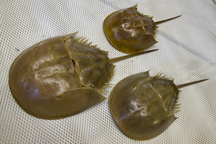
by Rick O'Connor | Apr 10, 2015
These curious ancient animals have been roaming the waters of the Atlantic and Gulf of Mexico for over 450 million years. Though they appear dangerous they are quite harmless and are actually more closely related to spiders and scorpions than crabs. Horseshoe crabs are not as common in Pensacola as they are in Panama City and Port St. Joe areas, but once were once found here and occasionally still are. Many coastal states have been concerned by the decline in their numbers. In the Chesapeake area where they were once very common, horseshoe crabs are harvested for their copper-based blood and also as bait for eel fishermen. The copper-based blood contains lysate which has been used to detect bacterial contamination in many drugs, as well as use for the diagnosis for some diseases.

The ancient horseshoe crab. Photo UF/IFAS Communications
Though there is a fishery for them in Florida, the issue with most locals is just the loss of a really neat animal that has been around longer than the dinosaurs,. This time of year, near the full moon, horseshoe crabs begin to gather near nesting beaches to mate and lay eggs. The Florida Fish and Wildlife Conservation Commission is asking locals and tourists who find a horseshoe crab to report it. They are interested in sightings of both adults and juveniles (less than 4” in length), the date seen, the time, the location, and type of habitat if possible. To report you can visit their website (www.MyFWC.com), email at FWRI@horseshoe@fwc.state.fl.us , or call 1-866-252-9326
If you have any questions contact your county Sea Grant Agent for more information.

by hollyober | Apr 8, 2015
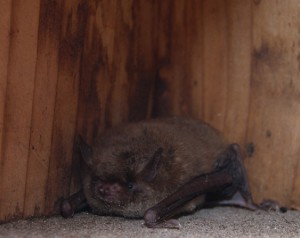
Bats are extremely beneficial, but they can be unwelcome guests when they choose to roost indoors, like this evening bat. Photo credit: LeiLani Davis.
Bats typically sleep during the day in natural structures such as trees and caves. In areas with few natural roost structures, bats may instead choose to spend their days in buildings.
Bats are beneficial because each bat consumes hundreds of insects per night. Bats save farmers billions of dollars annually by substantially reducing the abundance of insect pests. However, they can be unwelcome guests when they choose to live in buildings. The safe, humane, effective way to coax a colony of bats out of a building permanently is through a process called an ‘exclusion’.
A bat exclusion is a process used to prevent bats from returning to a building once they have exited. It is accomplished by installing a temporary one-way door. This one-way door can take many forms, but the most tried-and-true is simply a sheet of heavy plastic mesh screening (with small mesh size) attached at the top and along both sides of the sheet, but open on the bottom. The one-way door should be attached over each of the suspected entry/exit points bats are using to get in and out of the building.
It is illegal to harm or kill bats in Florida, but exclusions from buildings are allowed if you follow practices recommended by the Florida Fish and Wildlife Conservation Commission (FWC). According to Florida law, all bat exclusion devices must be left in place for a MINIMUM of 4 consecutive nights with temperatures above 50 o F before each entry point can be permanently sealed to prevent re-entry by bats. Also, it is unlawful in Florida to attempt to exclude bats from a building between April 15 and August 15, which is bat maternity season. This is when female bats form colonies and raise young that are unable to fly for their first few weeks of life. If bats were excluded during this time period, young bats (called pups) would die indoors.
For more information on how to conduct a bat exclusion, check out this video that features interviews with bat biologists from the University of Florida, FWC, and the Florida Bat Conservancy: How to Get Bats out of a Building.
For additional information on Florida’s bats, visit University of Florida’s bat advice or FWC’s bat website.
Remember, bat maternity season in Florida runs from April 15 to August 15. If you have a colony of bats roosting indoors that you want to exclude, you must either act quickly or else wait until the middle of August to coax them out.

by Judy Biss | Mar 27, 2015

Freshwater Jellyfish, Craspedacusta sowerbyi, Lankester, 1880. Photo Credit: U.S. Geological Survey Archive, U.S. Geological Survey, Bugwood.org
Yes, you read the title correctly, it says freshwater jellyfish in Florida! The first time I encountered these unusual aquatic creatures was while swimming in a small lake in southern Indiana. It turns out these jellyfish, while not very common, have been found in almost every state in the U.S. This jellyfish is known as a hydrozoan, a tiny aquatic invertebrate animal. It grows into a few different forms during its life-cycle and is most easily identified when it takes the form of the small jellyfish. This form during its life-cycle is known as a hydromedusa and measures up to about 25 mm in diameter, which is a little larger than a penny.
The scientific name for this unusual organism is Craspedacusta sowerbyi and it is native to the Yangtze River valley in China. It was first described to science in 1880 from specimens collected in water lily tanks in London. This freshwater jelly is now common in temperate climates almost worldwide, and was most likely introduced into the US attached to ornamental aquatic plants and fish.
Hydromedusae, the form that looks like a jellyfish, are produced only sporadically from their otherwise immobile attached form known as a polyp on lake and river bottoms. Sightings of the jellyfish are most common in summer and fall but may go several years between occurrences. The freshwater jellyfish mainly eats tiny aquatic zooplankton, catching them with their stinging tentacles. They are not considered dangerous to humans.
The impact this non-native freshwater jellyfish may have on aquatic ecosystems is not well known. Sightings of this organism are being recorded by the U.S. Geological Survey Nonindigenous Aquatic Species Information Resource and EDDMapS (a web-based mapping system for documenting invasive species distribution, launched by the Center for Invasive Species and Ecosystem Health.)
Based on data from these resources, the freshwater jellyfish, Craspedacusta sowerbyi, has been found in the following north Florida counties: Escambia, Walton, and Washington counties, and in the following peninsula Florida counties: Lake, Hernando, Highlands, Orange, Miami-Dade, Pasco, and Putnam.
So, while you’re enjoying your favorite freshwater swimming hole this summer, keep a sharp eye out for these harmless, fascinating, yet non-native, jellyfish! If you find them, report your sightings here at EDDMaps.
Information from the following resources were used to write this article:




































